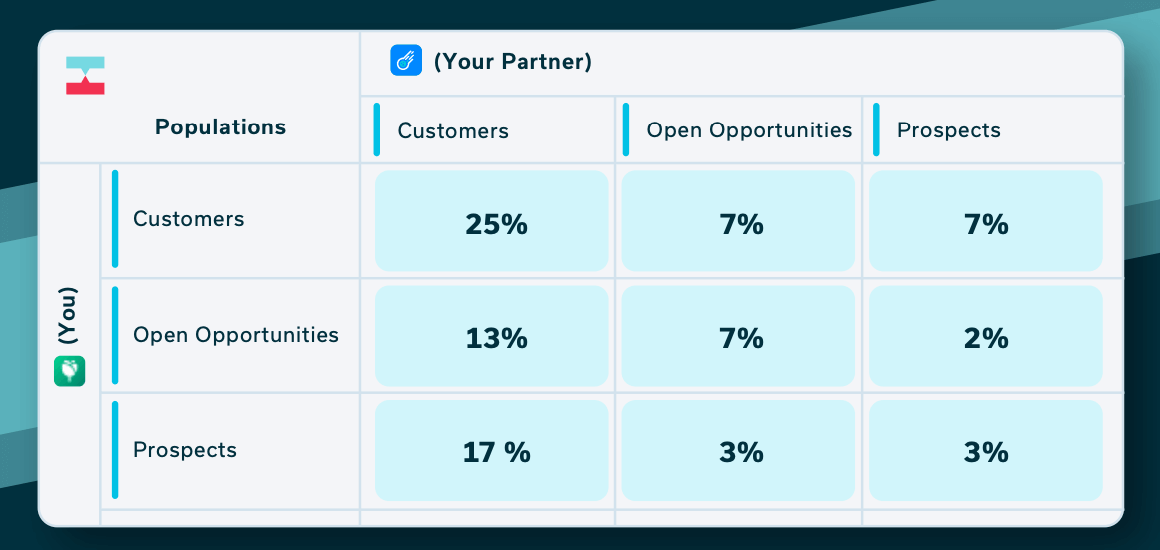Ecosystem-led growth is the buzzword of the day. Business leaders everywhere are embracing the tested-and-true wisdom behind co-branded marketing and applying it to every aspect of innovation, development, marketing, sales, and customer success.
The principles behind ELG are deceptively simple: leverage the knowledge, data, reputation, and reach of other organizations in your business ecosystem to drive innovation, sales, revenue, and growth for you both. But there’s one little-mentioned factor that can derail your whole strategy if overlooked: team alignment.
Why Team Alignment Can Make or Break ELG
Cross-functional alignment is the foundation on which ecosystem-led growth is built. If every member of your team isn’t starting from the same baseline and working toward the same goals, your efforts will go nowhere fast.
Did you ever participate in three-legged races as a kid? With your left leg tied to your partner’s right, the two of you had to cooperate and work in unison to win. Imagine trying to make progress if you and your partner had different ideas of where the finish line was. Or if you weren’t even facing the same direction when the race started? Your race would involve an unreasonable struggle to make progress and no real results.
A lack of team alignment on ELG strategy is pretty much the same situation (but with much higher stakes).

4 Steps to Building Cross-Functional Alignment for ELG
Ensuring team alignment is critical to ecosystem-led growth, but achieving it doesn’t have to be challenging.
1. Select Your North Star Metric(s)
Whether or not you’ve heard the term before, the concept of north start metrics is pretty straightforward. Everyone in your organization needs a metric (or metrics) to set your course against. (Like how explorers throughout time have used the North Star to find their way.)
What is a north star metric exactly? North Star metrics capture the core value you offer to your customers. There is no right or wrong metric to choose. It’s simply a KPI all parties can keep in their sights to ensure you’re all working toward the same goal.
2. Identify Your Partners
Not every business in your ecosystem will make a suitable ELG partner. And your product team may have a very different idea of the ideal candidate than your sales or marketing teams.
Remember, you’re not looking for a channel partner here. Ecosystem-led growth isn’t about finding someone to resell or promote your products and services. It’s about identifying partners who can help spur innovation and growth at your organization (and vice versa). Consider the following when selecting prospective ecosystem partners:
- Values and vision: Working with a partner whose values don’t vibe with yours is a quick way to alienate customers and shrink your market share.
- Synergy: You need a partner whose offerings complement yours (but don’t compete with them) to yield a collaboration that will drive sales
- Reliability: If you can’t trust your partner to deliver on their part of the agreement, your chances of wasting time and resources skyrocket
- Customer potential: This matrix can help you evaluate overlap among customers, prospects, and opportunities to determine if a potential partner is a good fit.

Image Source: Crossbeam’s account mapping matrix
3. Assign Responsibilities
Once you add a partner (or partners) to your strategy, team alignment plays an even more significant role in the success of your ELG strategy — because you’ve just added a whole bunch more teams.
- Product development
- Marketing
- Sales
- Customer success
- Who will lead development?
- Which teams are responsible for producing which marketing assets?
- How will sales be attributed?
- Who follows up with customers?

4. Measure Results
“You can’t manage what you don’t measure.” That phrase has been around longer than I have, but it’s still relevant. Don’t get caught up in the excitement of your partnership and stop paying attention to the results your strategy yields.
Be sure to set goals and milestones — again, both internally and across your partnership — before diving into development, marketing, or sales plans. Remember your North Star metrics. They can help you measure whether your ELG strategy is pushing you closer to your goals or just distracting you from them.
As with channel marketing, measuring the ROI of an ecosystem partnership isn’t always easy, especially if data doesn’t flow freely between your organization and your partners. If you find progress on your North Star metrics is lagging, double-check your team alignment on factors like:
- Target audience, buyer personas, and ICPs (Who are you selling to?)
- Key collaboration goals (What problem are you solving for customers?)
- Messaging (How are you presenting your solution?)
- Timelines (Is this a slow burn or a quick turnaround?)
Let TPM Support Your ELG Strategy
Struggling to secure the cross-functional team alignment you need to make ecosystem-led growth work for your business? Sometimes an impartial third party can help. The team at TPM has years of experience helping companies of all sizes navigate the pitfalls of ecosystem partnerships. Contact us to discuss your needs.
